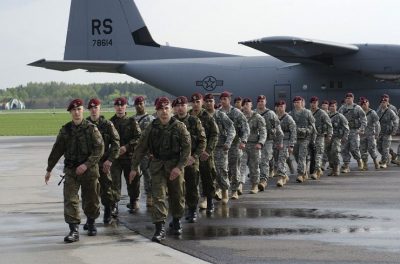Poland Just Became America’s Most Important NATO Ally

The US’ decision to dispatch 1,000 additional “rotational” troops and even a squadron of surveillance drones to Poland makes the Central European country its most important NATO ally because of the threat that this poses to Russian strategic interests in Kaliningrad, Belarus, Crimea, and Eastern Ukraine, which in turn revives the historical rivalry between these two regional powers over the shared space between them.
International commentators usually debate which of the US’ NATO allies is its most important one, but there should be no question nowadays that it’s Poland after the recent military deal that it clinched with the Pentagon last week. The US will dispatch 1,000 additional “rotational” troops on top of its already-existing presence of 4,500 ones and even deploy a squadron of surveillance drones to the Central European country in response to its request to beef up its military capabilities, which blatantly violates the 1997 Russia-NATO Founding Act by expanding the already-existing de-facto permanent NATO military presence in the region under the unconvincing cover of it only being “rotational”. Furthermore, it poses a serious threat to Russian strategic interests in Kaliningrad, Belarus, Crimea, and Eastern Ukraine, which in turn revives the historical rivalry between these two regional powers over the shared space between them.
Its not the author’s intent to fearmonger that “war is imminent” like a lot of Alt-Media analysts are prone to do when discussing this issue (in which case a few thousand troops anywhere in the world wouldn’t make much of a difference if the conflict goes nuclear), but just to point out the larger strategic impact of this decision, especially concerning the surveillance drone announcement. The US routinely attempts to violate Russian airspace with its spy planes, so it’s not unforeseeable that it’ll do the same with the Polish-based drones when it comes to Russia’s neighboring region of Kaliningrad, which is fast transforming into a fortress in response to the growing security threats unleashed by the US since 2014’s reunification with Crimea. In fact, the same type of surveillance missions could be undertaken from the US’ de-facto military bases in Poland against Belarus, Crimea, and Eastern Ukraine, thus making the country a hub for regional provocations.
Poland’s reinvigorated assertiveness towards its eastern periphery is due to a large part by its desire to restore its historical hegemony in the region that it regards as being within its so-called “sphere of influence”, which overlaps with the US’ strategic objective of “containing” Russia and therefore makes the country its natural “Lead From Behind” partner in this respect, a leadership position that’s vastly improved by the fact that it has the largest population and economy of the former communist satellites. Furthermore, the Polish-led “Three Seas Initiative” aims to expand the country’s soft power influence all throughout this domain, attractively presenting an alternative sub-regional development model between the “traditional” EU and the Eurasian Union. Now, with the US’ military support, Poland is attempting to expand its hard influence and might even possibly be planning to provoke Russia through the aforementioned scenario of violating its airspace with surveillance drones.
It’s difficult to predict what Russia’s response to this development will be apart from increasing its military capabilities in Kaliningrad like it’s usually done whenever something of this sort has occurred. While some people think that it’ll boost its military presence in CSTO-ally Belarus, there are realistic limits to what it can do given Minsk’s geopolitical “balancing” act between East and West. It’s technically true that the US’ new military deployments to Poland pose a security threat for the so-called “buffer state” between it and Russia, but Lukashenko knows that allowing his eastern neighbor to open up its long-sought-after airbase in the country would immediately jeopardize his relations with the West and might be a “crossing the line”, so it’ll remain to be seen how the Russian-Belarusian Strategic Partnership is leveraged in this respect (if it even is to begin with).
Nevertheless, from an American strategic perspective, the scenario of provoking a self-sustaining cycle of revived historical rivalry between Poland and Russia is already being advanced through this latest military decision and will therefore create a somewhat predictable regional model that the US can continue to work with going forward. It’s to the US’ benefit more so than anyone else’s to see Poland and Russia once again compete for the shared space between them, which therefore enables Washington to “contain” Moscow by proxy via Warsaw, or at the very least force its competitor to contend with yet another problem on its borders as it seeks to overwhelm it with security challenges. It’s for this reason why Poland is incontestably the US’ most important NATO ally and will likely remain so for the indefinite future because of the irreplaceable role that it fulfills for American grand strategy.
*
Note to readers: please click the share buttons above or below. Forward this article to your email lists. Crosspost on your blog site, internet forums. etc.
Andrew Korybko is an American Moscow-based political analyst specializing in the relationship between the US strategy in Afro-Eurasia, China’s One Belt One Road global vision of New Silk Road connectivity, and Hybrid Warfare. He is a frequent contributor to Global Research.
Featured image is from NEO

